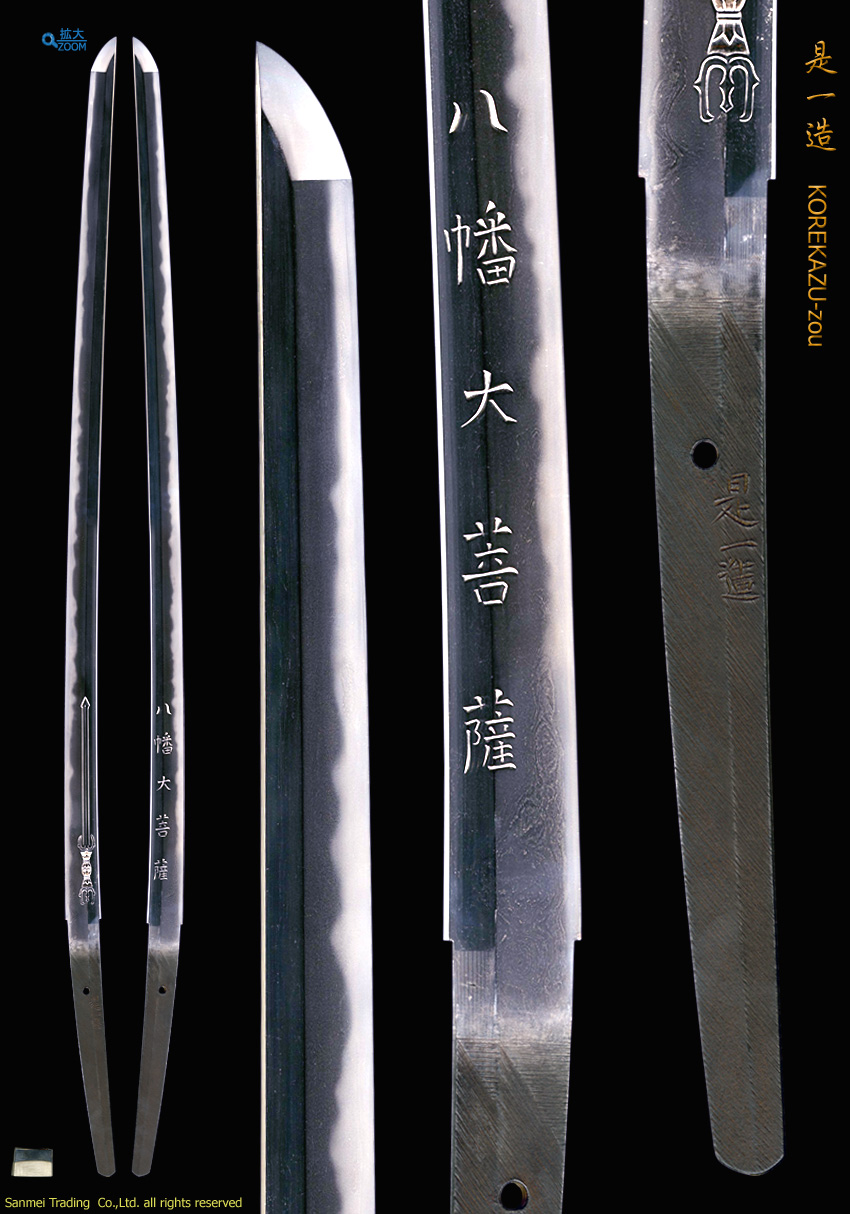with) a published book 『Kurogane-no-Isho II』
Placed on the exhibition [Kurogane-no-Isho II]
Length of cutting edge 75.4cm Curvature 0.8cm Width of base 30.4mm Width of Yokote 20.7mm Thickness of base 7.3mm
Engraving(Horimono): A sword with three-pronged handles Sanko-ken in front and the other side is the title for the Great God of Arms Hachiman Daibosatsu
Forging(Hada): Forging is fine Ko-Itame-hada in general and large Mokume-hada appears upper the Hamachi area with abundant indication of bright curved line of Chikei. The entire Hiraji surface is covered in intense Ji-nie particles that sparks extremely bright and clear.
Temper(Hamon): Hamon is a rather stronger side fine Nie hard metal granules base, shallow undulating NOTARE mixing in combined tassel-shaped Choji with indication of Togari gunome varies in shape where works with excessive sparkling Nie with supreme minute martensite particles which appears uniform from base to tip. In the interior of temper, there appears brilliant Nie-ashi and deep Noi mist-like crystalline area and exquisite activity of Sunagashi.
Temper of tip(Boshi): Boshi forms irregular Midarekomi,small circle turns back.
Tang(Nakago): Nakago is in UBU original. One peg retaining hole. Greatly slanting left filemarks with horizontal Kesho. The Nakago heel is Kurijiri (double-bevelled) at the end. The inscription signature is located in front upper side of the Shinogi-ji side KOREKAZU-zou 是一造.
Here is a remarkable piece of katana by the 7th gen. Unju KOREKAZU 運寿是一 who excels in Bizen-den workmanship of Ishido school and ranks as Jo-jo-saku (above superior made).
Unju KOREKAZU 運寿是一, real name Ishodo Seitaro 石堂政太郎, was born in Bunsei 3rd (1820), a nephew of Cho'Unsai TSUNATOSHI 長運斉綱俊. He was adopted into a family of 6th gen. Unju KOREKAZU then succeeded to a title of Unju KOREKAZU 運寿是一 to settle his atelier in Azabu, Edo in Tenpo 12th (1841) when he was 21 years old.
He is known under the name of Unju-sai 運寿斉 and served for the Tokugawa Shogunate as well as Meiji government after the Meiji Restoration.
This is a made-to-order katana by high class Samurai to rely on divine protection and grace cause of the elaborate workmanship of religious engravings on both sides.
This katana is representative of the Shin-shin-to period and had been displayed on the exhibition of [Kurogane-no-Isho] held in Ibaraki Prefectural History Museum.
Double layers Habaki collar (lower is Shakudo and upper is silver foiled). Preserved in Shirasaya plain wood mounting.
The subject printed book [Korogane-no-Isho II] is annexed
reference data :
Ibaraki Prefectural History Museum, Kurogane-no-Isho II, 2000
Honma Kunzan/Ishii Masakuni, Nihonto Meikan, Yuzankaku, 1975


